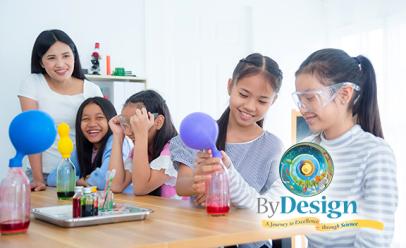 By: Kendall Hunt RPD with contributions from the editorial team of ByDesign Science
By: Kendall Hunt RPD with contributions from the editorial team of ByDesign Science
What is your individual learning style? Can you identify the preferred learning style of each of your students?
If you give it some thought, it is more likely than not that every possible learning style is represented in your classroom. That can make it difficult to provide a successful learning environment for all your students, but there is one method that will have all the present learning styles covered.
More hands-on exploration in your classroom rather than listening, reading, and regurgitating information can ensure success for all your students. Various grade levels experience their own student limitations when discussing a topic, like gravity and forces, that may be uninteresting or just plain confusing for students. Supplementing with a hands-on exploration activity will help combat these learning barriers. For example, showing your students what happens when you push a toy car across the floor while introducing new vocabulary from the lesson they just read. It’s very likely that they are more engaged, and visual learners will have a better understanding of the concept you are teaching. In the end, however, how much of what you just showed them will they remember?
Learning styles may change by allowing your students to form small groups to conduct this experiment on their own. By doing this, students of all grades are going to start thinking about what factors affect how far the car will move because they are going to get to experience the lesson for themselves. You can guide their experience by giving them specific questions they need to discover the answer to during the exploration exercise. Requiring a written analysis of the results or some type of visual representation of the data they collect will also help further their understanding.
Utilizing this type of hands-on approach will satisfy all learning styles. Visual learners will see the concept in action. Auditory learners will benefit from the concept discussion with their classmates. Kinesthetic learners will get the experience of physically conducting their own experiment. And those with a reading/writing preference can record what they have seen to help them review and process the experiment.
Science seems like the logical subject to apply this type of teaching style to, but this can also be applied to language arts, math, and social studies. For students working on strengthening their reading skills, you can have them work with a group to conduct a reader’s theater, acting out what they are reading or even what they have written. Math students can use manipulatives to work out problems. In social studies, students can develop their own maps, or create models of what they are learning about.
Of course, doing these types of activities makes for a louder than normal classroom, but it will also make learning and retaining lessons for your students much more memorable and effective. Let students get out of their desks, move around, and try doing these lessons with some guidance from you. In the end, you and your lesson will likely be the topic at dinner that night—in a good way.
Custom inquiry-based curriculum solutions offer you greater control over your students’ success. With content tailored to your specifications, you can guarantee the material you’re providing your students upholds the mission and values of your school.